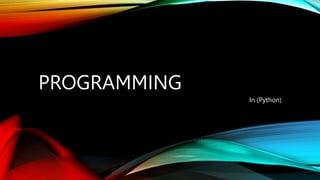
Computer Sience, This is my presentation for beginners coding in python
- 2. STRINGS • A string is a data type that is used to represent a sequence of characters. Such as numbers, text, spaces, punctuation, user name, communication with users, a whole sentence or paragraph of data. Strings must be enclosed in quotation to distinguish from variable names.
- 3. BASICS OF WORKING WITH STRINGS • Indexing Each character in a string has an index number, with the first character at position 0. You can use the index to reference individual characters in a string. • Length Length function : To find the number of characters In a String • Traversal To cycle through each character of a string. Mainly using Loops
- 4. MORE STRING MANIPULATION • Finding Characters with a certain Index The index of a character is the position of that character within a string. Which can be accessed using square brackets. • Changing Casings of Characters • Extracting Characters By selecting characters from indexes 3 to 6, It leaves out the rest. Printing “put” • Checking Characters ‘put’ and ‘PUT’: ‘put’ is a substring of ‘Computer Science’ but ‘PUT’ is not, so these examples will display ‘True’ then ‘False’.
- 5. DATA STRUCTURES • A data structure is an organized collection of related elements. There are many different data structures that can store multiple data items used in programming.
- 6. ARRAYS • An array is an organized collection of related values with a single shared identifier. All the elements in an array are the same data type, where each has a unique index value denoting its position in the array. • One/ Single dimension array where the data are stored in the sequential order. For example, it can be used to store name or mobile number or grade • A multidimensional array is an ‘array of arrays’; where each item at an index is another array
- 7. LISTS • Lists are easier to use as they are dynamic – they do not have a fixed size and can grow as new elements are added. When they are declared they do not have to be given a size and can grow as new elements are added. • In Python, arrays are not commonly used. Instead lists are used but they are very similar in the way that they operate. Just like an array, a list is created by adding items, separated by commas, inside square brackets
- 8. WHICH ONE TO USE ? :
- 9. ALGORITHMS • An algorithm is a precise method of solving a problem.
- 10. VARIABLE INITIALIZATION & DATA TYPES • When algorithms are converted into programs, the computer needs to be told what type of data is stored in each variable. Every programming language has a number of built-in data types. • When a variable is declared, the computer gives it a location in its memory. Initially, this location is empty, so before a variable can be used it has to be given a value.
- 11. SEQUENCE : SELECTION : ITERATION • There are three key building blocks of algorithms : They are command sequence, selection and iteration.
- 12. • Sequence • The order in which instructions occur and are processed • Selection • Making decisions by asking a question & depending on the outcome, follow one of the two paths or take certain actions & ignore others
- 13. SELECTING WITH IF STATEMENTS: • The IF statement is a decision- making statement that guides a program to make decisions based on specified criteria • The Nested if statement allows you to create a chain of if statements. The if statements are evaluated in order until one of the if expressions is true or the end of the if chain is reached. If the end of the chain is reached without a true expression no code blocks are executed.
- 14. ITERATION (LOOPS) : • Indefinite Loop : A loop where it is not easy to know amount of execution required. • Definite Loops : A loop that executes a known number of times. This type of loop can be executed using while statements This type of loop can be executed using for statements Nested for Loop : The inner loop will finish all of it’s iterations before finishing one iteration of the ‘ outer loop’